
With shattered legs and a crippled soul, Xena went east to lose herself in vengeance, not against Caesar,
but the entire human race.
A tale of bloodlust, wisdom and power follows - all in the Kingdom of Chin.

After Caesar tried to execute her in "Destiny", why did Xena head east? Why did she not hang around the known world, taking revenge on Caesar, or at least killing Romans (as she did ten years later in "The Deliverer" & "When In Rome..."? Why did she head off into a strange and remote country? What made her think she could survive there?
One argument is that women in nomadic tribes enjoyed a status not found in the 'settled' world, due to the fact that a woman could ride and fight on horseback as well as a man. For Xena, who at this time was unable to walk properly, but formidable in many ways on horseback, this was the obvious and only choice.
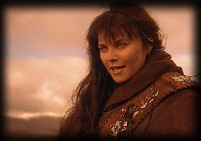
Another possible explanation is that Xena was a fugitive with no troops left, hated all over Greece, and would not have lasted a week in a Roman-dominated land. Although probably true, this is a less poetic explanation. Perhaps Xena was just very lucky that the only option left open to her suited her circumstances so well.
A wounded Chinese messenger staggers into Xena and Gabrielle's campsite one night and collapses. He tells Xena that he's been sent by the `Weak One,' which provokes a strong reaction in her. Suddenly, six Chinese warriors come charging out of the trees and try to kill the messenger. When Xena leaps to his defense, her combat skills are pushed to the limit by the warriors' amazing Hong Kong-style fighting moves. When she is finally able to defeat them all, she turns to the dying messenger in time to hear him whisper what he has come to tell her.


After hearing his words, Xena tells Gabrielle that she must go to the Kingdom of Chin to kill the `Green Dragon' and urges her friend to stay behind. Gabrielle refuses and as the two women begin their long journey, Gabrielle prods Xena into explaining who the Green Dragon is and why she feels compelled to kill him. Xena launches into the story...

Somewhere on the plains in the days of Xena's dark past, a band of warriors pursues a group of Asian soldiers. Borias, the head warrior, launches a furious attack on the soldiers and quickly defeats them in battle. As the last couple of Asian soldiers surrender, a mysterious bloodthirsty warrior, who turns out to be Xena, gallops into the fray. She kills one of the soldiers by impaling him on her sword, but is stopped by Borias before murdering the other.

How Did Xena Get To Chin (The First Time?)
We know the first part of Xena's journey. It was shown on the map in "The Debt". Unfortunately, far beyond the Caspian Sea, the map on screen dissolves into a spectacular view of the Rangipo Desert.
Xena's route up to that point, however, is well-defined: through Macedonia, skirting the shores of the Aegean Sea; across the Dardanelles into Asia; and across the Anatolian plateau of Turkey, through the mountainous area east of Erzerum, to Baku on the Caspian Sea. This was the northern fringe of what had been Alexander's empire (c. 300 BCE). Presumably, the disintegrating remnants of an empire suited a fugitive like Xena. She must have taken a ship across the Caspian (unless she parted the waters like Moses).
Somewhere in the wastes to the east she would have met Borias.

A short while later, Borias and Xena are visited by the enormously wealthy and powerful Ming Tzu and his 12-year-old son, Ming T'ien. The shrewd Borias makes a show of respect to the mighty leader, but Xena refuses to be impressed. The boy, Ming T'ien, is transfixed by her as the two men discuss a deal. Borias is to raid the Lao province while Ming Tzu remains neutral.

In return, Ming Tzu will get half of everything Borias, Xena and their men are able to steal. Xena loudly rejects this proposed arrangement and infuriates both Borias and Ming Tzu.

Xena continues her story...Outside of Borias' yurt, a canopied litter approaches carrying the breathtakingly beautiful Lao Ma. Both Borias and Xena are surprised by her arrival and as she greets them, she explains that she is the wife of the great Lao and has come in his place because he has fallen ill.
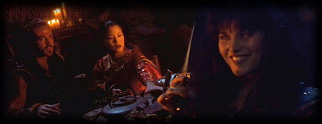
That evening, as they sit around eating and drinking, Xena becomes increasingly jealous over Lao Ma's flirtations with Borias. Later that night, Xena tries to kill Lao Ma, but much to her amazement, the Asian beauty proves to be a formidable adversary. With amazing martial arts skill, Lao Ma easily deflects Xena's attack and overpowers her. When Borias shows up, Lao Ma tells him that the deal they discussed earlier is off.
Borias is incensed and threatens to kill Xena if she refuses to leave by morning. Xena then devises a plan to accomplish what Borias has only dreamed of -- to get rich with the help of one of the great houses of Chin. Xena steals into Ming's Palace and kidnaps Ming T'ien. When Borias shows up at her hiding place, Xena tells him exactly how the plan will work -- she will return the child in exchange for horses and gold from Ming Tzu, and as compensation for his help, Borias will receive five percent.

As the plan unfolds, it turns out that Borias has double-crossed Xena and in fact, has given her over to Ming Tzu to be killed.

As the story continues, Gabrielle struggles with the knowledge of how ruthless Xena once was and decides she can't go with Xena to kill the Green Dragon after all.
We know how Gabrielle got there from "Forget Me Not". She had help from Ares.
All we know of Xena's trip is that she took passage on a boat which "would carry her close to the Kingdom of Chin". ('Close' is a relative term in the Xenaverse!) However, this probably rules out the overland Silk Route.
There is some doubt about her starting point. "Gabrielle's Hope" takes place entirely in Britannia. At the beginning of that episode Xena was negotiating with a Phoenician trader for passage to Greece, however events overtook this. At the end of the episode, Gabrielle was standing alone in the moonlight near their camp.
"The Debt" starts with an almost identical moonlit scene, which tempts us to think it follows immediately on from "Gabrielle's Hope". However, I think it more likely this is some time later, in Greece, after an un-shown sea voyage, probably courtesy of another Phoenician trader. It is hardly likely that Lao Ma's messenger would have tracked Xena all the way to Britannia, nor would this fit easily with subsequent events.
Xena and Gabrielle make a land journey before Xena catches the ship for Chin. Xena's final port of debarkation would have to be a Red Sea or Persian Gulf port. To reach there by land, they would have to travel through Macedonia, Anatolia and much of the Middle East. Far quicker and more practical would be a sea voyage across the Mediterranean to Alexandria or Gaza, from where a short overland journey would reach the Red Sea. Thus, Xena and Gabrielle's journey takes place in Greece, and Xena parts from Gabrielle at a Greek port. Xena's statement that the ship would 'carry her close to Chin' must be taken metaphorically as including en-route transfers.
Shortly after the discovery of the steady monsoon winds in 100 BCE, up to 120 Greek vessels a year made the journey to Indian ports such as Muziris (near Trivandrum in southern India), from where 'possible' (as my atlas says) Chinese routes ran to Panyu (not far from Hong Kong). Panyu is on the southern coast of China, 1200 miles from Lanchow (or anywhere else on the Great Wall). Did Xena travel 1200 miles overland? And how did Xena and Gabrielle get back to Greece afterwards? "The Debt" does not say.
Of course, Ming T'ien's castle could have been near the eastern end of the Great Wall, near the coast, but that would have made 600 miles further for Xena and Borias to travel on their raid, right along the wall. While "The Debt" gives no clues as to where they assailed the wall, it appears from the context that it was their first sight of it. There is no suggestion that they skirted it for 600 miles before attacking.

As Xena proceeds on her mission alone, the story flashes back to her being taken into Lao Ma's territory by Ming and his soldiers, locked in a cage. Ming Tzu explains to Lao Ma that he is about to set Xena free to be hunted down by his dogs for sport.

Lao Ma wishes them well and gives Ming T'ien a gift -- a cloth with a sad-looking green dragon on it.
Soon, the hunt begins...
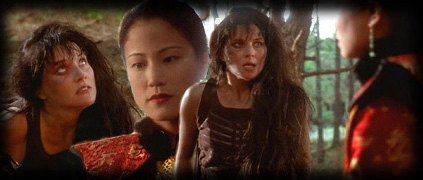
Xena is let loose through a thicket with a pack of hounds at her heels. During the ensuing chase, she is suddenly intercepted by Lao Ma, who urges Xena to come with her if she wants her freedom. Lao Ma explains that she has the ability to see into the souls of others and she knows that Xena is a remarkable woman, capable of greatness. Lao Ma takes Xena to her palace and hides her there.

Back in the present day, Xena has arrived at Ming's Palace and finds a way in. She enters the room of the Green Dragon. As she lifts her knife to plunge it into the chest of the figure beneath the sheets, she soon discovers that it is Gabrielle lying there. Xena stares at Gabrielle in shock as Gabrielle explains that she cannot let Xena commit murder -- that she's intervened for Xena's own good.

Suddenly, Ming T'ien enters the room -- now a haughty and handsome 21-year old with a ferocious green dragon tattooed on his chest.
Where Was Ming T'ien's Fortress?
We know that Ming T'ien's fortress was built on one of the Walls of China, as we see a brief moonlit view of it as Xena prepares to break in and assassinate Ming T'ien. It is the same location as the point where Xena built her 'wall of heads' ten years earlier.
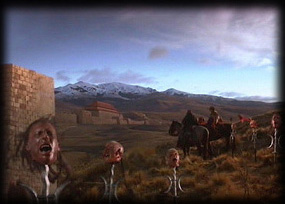
The building, and the adjacent wall, are substantial stone structures. Such a building would be a fort guarding a gate in the wall, rather than the ruler's palace, which would be located in his capital in the interior of his kingdom. However, it is likely that a ruler would stay for a while in such a fortress as he traveled about his dominion.
There were, in fact, a great number of walls in China, built by warring kingdoms from 450 BCE to 220 BCE, frequently pulled down by conquerors or incorporated in their own defensive walls. The earliest walls were built either for protection from neighbors, or to keep out the raiding nomads from the north.
After the Ch'in Empire came into being, the emperor Qin Shi Huangdi had the "Great Wall" built along the northern perimeter of his empire, incorporating parts of earlier walls, as a protection against the barbarians (though Qin himself was probably more barbaric than any nomad). The work was carried out around 220 BCE, and it stretched from Lanchow to the sea, enclosing the great loop of the Yellow (Huang) River.
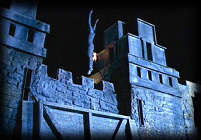
This was probably over-ambitious, as the huge area inside the loop of the river, the Ordos, was semi-arid and more suited to nomads than to Chinese farmers. It is significant that when, in the 17th century C.E., the Mings built the Great Wall we know today, for protection against the Mongol hordes (still doing the barbarian nomad thing!), they used the old 300 BCE alignment south of the Ordos.
The Han empire which succeeded Ch'in extended the Wall as far as the Jiayuguan Pass to protect their trade 'corridor' to the west past the Tien Shan mountains and the Takla Makan desert (this is the area north of Tibet which is 'off the edge' of the maps in almost every atlas).
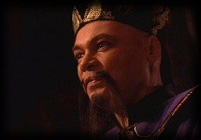
Most of the Ming Great Wall was built of brick or stone. The early walls were built of whatever materials were locally available. This included stone in the mountains; rammed earth in loess areas; timber; and (in the Gobi) layers of sand, pebbles, tamarisk twigs, and reeds. Important forts and gates may have justified more substantial construction than the rest of the wall.
The area near Lanchow seems to have been about the north-west limit of the fertile area of China, and also the nearest section of Great Wall from Xena's direction of approach (in Ch'in times, before the Han built the western extension). It was also an area of great strategic importance, which would probably justify the imposing stone wall and fort seen in THE DEBT. This is the most plausible location of Ming T'ien's fortress.

Ming T'ien, the ruthless young Emperor of Chin who is also known as the "Green Dragon," orders that Xena be thrown into a dark polluted pit filled with stagnant water and a group of filthy half-starved prisoners. He flatly refuses Gabrielle's repeated pleas to see her and begins to tell Gabrielle how Xena's cruelty changed his life and taught him how to rule when he was just a young boy. He recalls how Xena kidnapped him and held him for ransom inside a walled-up cave before returning him to his father, Ming Tzu. Gabrielle is appalled by the tale, as well as her growing realization that she is dealing with an absolute maniac.

Meanwhile, Xena finds out that her fellow prisoners are from the Kingdom of Lao and soon learns that Lao Ma was publicly executed by order of Ming T'ien.

Xena flashes back to one of her early encounters with Lao Ma as Lao Ma demonstrates her astounding telekinetic and physical powers. Lao Ma tells Xena that in order to transcend the limitations of her blind and ruthless will, she must give up desire and hate. In fact, she must extend herself to serve someone she hates. In an extraordinary test of will, Xena agrees to pose as a servant girl in Lao Ma's palace when the ruthless Ming Tzu and Ming T'ien come for dinner.

Taking this first step to master her own will, Xena maintains her self-control and refrains from killing him.

Lao Ma then takes Xena to the bedside of her comatose husband, Lao Tzu, and explains that she has been using acupressure to keep him alive in order to prevent his imbecile cousin from becoming king. She reveals that Lao Tzu was actually a vicious tyrant and it is she who has decided to make him the most loved of rulers by doing good works in his name. Lao Ma also reveals to Xena that she is Ming T'ien's mother.
Lao Ma's Questionable Parenting
Lao Ma never made Xena responsible for her actions. She also never seemed to want to understand how badly Ming T'ien was abused and emotionally wounded by Xena's sadism. His father, Ming Tsu, acted as the responsible parent. He punished his son's abuser and tried to insure that Xena would never hurt Ming T'ien again. He tried to give Ming T'ien a sense of safety and closure by encouraging him to watch Xena's punishment.

Back in the present, Gabrielle thinks she has convinced Ming T'ien to let Xena go if she promises she'll never attempt to kill him again.

But when Xena is brought in, she is lost in thought about how Lao Ma healed her legs, which were broken when she was crucified by Caesar.
A Giver of Life
A major factor in developing this archetype is Lao Ma's role as a giver of life. She saves Xena's life in the forest, protecting her from being hunted and killed by Ming Tsu and Ming Tien. When hiding Xena in the tub, Lao Ma literally breathes air into Xena's lungs to maintain her concealment and prevent her from drowning. At one point, Lao Ma is teaching Xena her technique, demonstrating how the hair broach can be used as a weapon. When Xena suggests it could be used to kill, Lao Ma responds by telling Xena she does not like to kill. This statement reaffirms Lao Ma's reverence for life itself. More poignant is Lao Ma's wisdom to Xena, saying, "You have been dead for a long time, Xena. I'm offering you a chance to live." Later, when Xena is recounting the story of Lao Ma to Gabrielle, Xena's words clearly demonstrate the symbolic life giving influence of Lao Ma. Xena explains that Lao Ma not only saved her life, but also her soul, spirit and entire being. Indeed, it was reflection on Lao Ma's teachings and guidance that helped set Xena on her path to redemption. Xena explains to Gabrielle,
"I was reborn. That's the debt".

Ming T'ien responds to Xena's silence by sentencing her to death.

Gabrielle is devastated that her plan to prevent her friend from committing murder has had such horrifying consequences and she goes to see Xena in prison that night. The two women reconcile and Xena explains that she feels compelled to kill Ming T'ien to avenge the death of Lao Ma.

Xena then recalls how Lao Ma tried to bring about a three-way alliance between Borias, Ming Tzu and herself, proposing that Xena help her run the Lao Kingdom. Ming Tzu refuses to discuss it until Xena suggests that she herself be put up as the stakes in a deadly game of chance, which results in her killing Ming Tzu.

When she then attempts to turn her sword on young Ming T'ien, she is stopped by the formidable Lao Ma, who summons her powers and sends Xena slamming into the walls around the room.
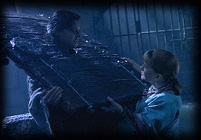
Xena now admits to Gabrielle that it took her years to figure out that Lao Ma just wanted peace for her land and what was best for Xena.

Lao Ma's Questionable Parenting Part 2
Although Lao Ma disliked Ming Tsu, she had to respect him as the custodial parent who was responsible for their son's upbringing. Instead, she allowed his death, thereby causing Ming T'ien to be raised by others. If Lao Ma had enough political power to rule the kingdom of Lao while keeping her husband in an enforced coma, she certainly had enough political acumen to oversee the upbringing of her son in the kingdom of Ming. After Ming Tsu's death, Lao Ma seemed passive about raising their son herself.

The mystery lies in what happened after Ming Tsu's death. Did Lao Ma try to heal her son's psychic wounds? Did she try to contain his power? Did she try to divert him from his evil ways? The only answers that are presented are that Lao Ma let her son kill her and that she asked Xena to kill him. Both answers point to a disturbing relationship between mother and son.

However, compelling evidence of the good mother archetype is found in Lao Ma's maternal nature with Xena. Lao Ma takes Xena into her home, bathes her, clothes her and tenderly combs out Xena's hair, as a mother would with her child. These actions seem to almost denote the symbolic rite of passage for the growth that awaits Xena in her mentor's care. Lao Ma becomes a teacher to Xena, attempting to guide the warrior's inner development by sharing her own personal philosophy of life.
Lao Ma's maternal demeanor with Xena lends to the creation of the good mother premise. Lao Ma often looks at Xena with the bemused look of a mother with an immature child. This look is best noted when Xena attempts to will the bottle to break. Lao Ma, as a result, resorts to amused laughter. The same look lightly touches across Lao Ma's face early on, in the scene where she revives Xena after sending her hurtling through the side of the tent.
Possibly the most powerful and poignant example of Lao Ma's nurturing of Xena, is in the levitation scene. Xena lays herself out before Lao Ma and closes her eyes, trusting and vulnerable. Lao Ma, using her 'gifts', heals Xena's limp. When Xena is roused out of her peaceful state, the scene that follows is reminiscent of a baby taking her first steps. Lao Ma holds out her arms to "her child" and commands, "Come to me, Xena." Xena stands, her uncertainty evident on her face, then looks to Lao Ma for reassurance. Then Xena is filled with joy as she realizes she can walk. Lao Ma symbolically draws Xena to her, displays her affection with an embrace, and the gently pushes Xena away and levitates her. The scene strikes a symbolic cord, as if Lao Ma is the mother bird, pushing the baby bird from the nest, teaching her how to fly. Throughout this scene, both Xena and Lao Ma react to each other with love, affection, and trust. The emotional impact of the scene is undeniable, and once again, the good mother aspect rings clear.

Dawn has arrived and as Xena is laid on the executioner's table, Lao Ma's teachings echo in her ears.
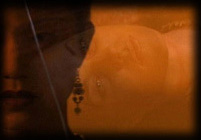
Just as the executioner is about to lower his hacksaw, Xena uses her mental powers to turn his own instruments of torture against him and break free of her chains.

Xena is determined not only to kill Ming T'ien, but to bring down his entire regime and a spectacular battle ensues.

When Ming T'ien emerges from the rubble of his collapsing palace, he brags to Xena that he personally executed Lao Ma, knowing full well that she was his mother and would therefore not use her powers against him. With a swagger, he then tosses a hair brooch in her direction, saying it was Lao Ma's dying request that Xena have it.

In the end, Xena uses this brooch -- a gift from Lao Ma -- to kill Ming T'ien. The debt has finally been repaid.

